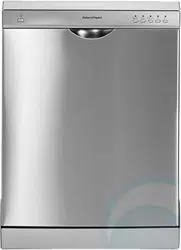Documents: Go to download!
User Manual
- Owner's manual - (English)
- Specifications
- Introducing your dishwasher
- Using your dishwasher
- Wash programme chart
- Caring for your dinnerware
- Dishwasher standards test
- Care and cleaning
- Fault codes
- Troubleshooting
Table of contents
Specifications
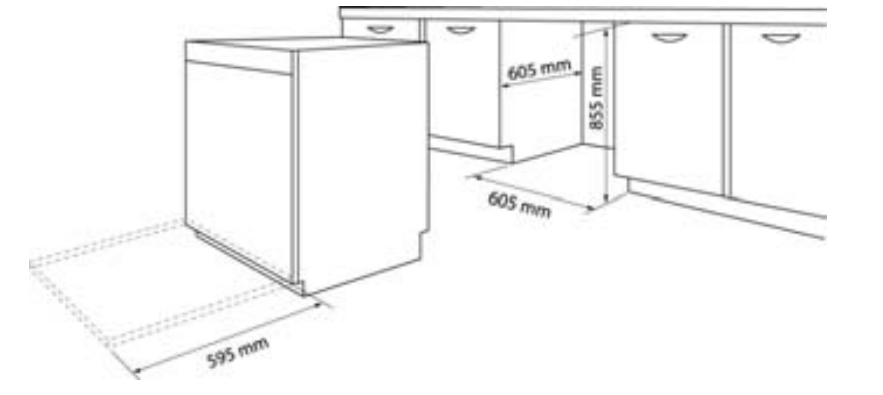
Model details
| Technical Data | |
|---|---|
| Width | 600 mm |
| Depth | 600 mm |
| Height | 850 mm |
| Capacity | 12 standard place settings |
| Mains water pressure | 0.03 – 1 MPa (4.35 - 145 psi) |
| Power voltage | 220-240 V - 50 Hz |
| Maximum current intensity | 10 A |
| Total absorbed power | 1950 W |
Introducing your dishwasher
Dishwasher interior
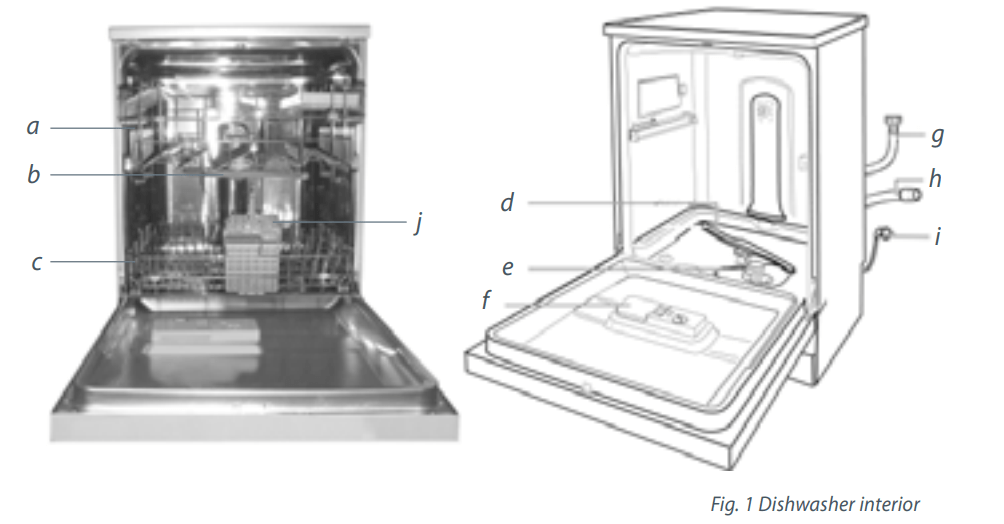
a Upper rack
b Top spray arm
c Lower rack
d Bottom spray arm
e Washing filter
f Detergent and rinse aid dispenser
g Water inlet hose
h Drain hose
i Power supply cord
j Cutlery basket
Using your dishwasher

a Power
b Programme button
c Programme indicator

a Power
b Reset button
c Delay start
d Time remaining indicator
e Heater indicator
f Rinse Aid indicator
g Programme button
h Programme indicator
Quick start
- Remove all food scraps and load the dishes.
- Add detergent.
- Check rinse aid.
- Check that there is nothing obstructing the spray arms.
- Close the door.
- Turn the POWER button ON. All the programme indicators will light up.
- Press the Programme button to select a wash programme.
After five seconds, the selected wash indicator light will flash when the programme is in progress, the dishwasher will beep once and the wash programme will start automatically. The Time Remaining display will display the estimated time for the programme (models DW60CDW2 and DW60CDX2 only).
At the end of the wash cycle, your dishwasher will beep six times, and all the programme indicators will light up.
8. Leave the door slightly ajar to improve the drying performance.
9. After several minutes, set the POWER switch to OFF.
10. Remove dishes once they are cool enough to touch.
Interrupting the programme
Models DW60CD
- Press the Power button.
- Open the door slowly.
Important! There is a risk of being sprayed with hot water. Do not open the door fully until the spray arm has stopped rotating.
- If the door is left open during the wash cycle the dishwasher will beep ten times every thirty seconds.
- When the dishwasher has been paused and the dishwasher has heated the water, leave the door ajar for several minutes and then close. Otherwise, the dishwasher door may open due to expansion.
Cancelling or modifying the programme
A wash cycle can be modified if it has only been running for a short time. The detergent dispenser may need to be refilled.
To cancel and reset a programme:
Models DW60CDW2 and DW60CDX2
Press the Reset button. One beep will sound, and all the programme indicators will light up, to indicate that the current programme was cancelled successfully. You can now select a new wash programme.
Models DW60CSW1 and DW60CSX1
Press the Power button.
Memory function (models DW60CDW2 and DW60CDX2 only)
If the power supply is switched off during a cycle, or the POWER button is accidentally pushed, your dishwasher is able to remember the current setting and place in the wash cycle. It will automatically return to the same place in the cycle, once power is restored (or the POWER button is set to ‘ON’), and will continue with the wash.
Delay Start (models DW60CDW2 and DW60CDX2 only)
This feature can delay the start of a wash programme from 1 – 12 hours. To activate the delay start:
- Turn your dishwasher ON.
- Press the Delay button. The Delay indicator will flash and the Time remaining indicator will change to ‘1h’.
- Press the Delay button, until the Time remaining indicator shows the required delay.
- Press the Programme button to select the desired programme.
- Once the door is closed, after five seconds, the Time remaining indicator will flash and the dishwasher will begin to count down the time remaining. It will then start automatically after the selected time.
Note: to cancel the Delay Start setting, press the Reset button.
Wash programme chart
Model: DW60CSW1 and DW60CSX1
Wash programmes – when to use
| HEAVY DUTY | NORMAL | NORMAL ECO | FAST | RINSE |
|---|---|---|---|---|
| Heavily soiled pots, pans and dishes. | Dishes with normal soils for optimum wash and dry performance. | Normally soiled dishes for optimum energy usage. | Very lightly soiled mixed dishes. | Rinses dishes that have been stacked for several days in the dishwasher prior to washing. |
| Hot pre-wash. | Cold pre-wash. | Cold pre-wash. | Short cold wash. | |
| Wash 70 °C. | Wash 55 °C. | Wash 42 °C. | Wash 40 °C. | |
| Cold rinse. | Cold rinse. | Cold rinse. | Cold rinse. | |
| Hot rinse. | Hot rinse. | Hot rinse | ||
| Drying. | Drying. | Drying. |
Model: DW60CDW2 and DW60CDX2
Wash programmes – when to use
| HEAVY DUTY | NORMAL | NORMAL ECO | DELICATE | FAST | RINSE |
|---|---|---|---|---|---|
| Heavily soiled pots, pans and dishes. | Dishes with normal soils for optimum wash and dry performance. | Light to normally soiled dishes for optimum energy and water usage. | Lightly soiled delicate items. | Very lightly soiled mixed dishes. | Rinses dishes that have been stacked for several days in the dishwasher prior to washing. |
| Hot pre-wash. | Cold pre-wash. | Cold pre-wash. | Wash 40 °C. | Short cold wash. | |
| Wash 70 °C. | Wash 55 °C. | Wash 42 °C. | Wash. 45 °C. | ||
| Cold rinse. | Extended wash at 55 °C. | Cold rinse. | Cold rinse. | Cold rinse. | |
| Hot rinse. | Hot rinse. | Hot rinse | Hot rinse | ||
| Drying. | Drying. | Drying. | Drying. |
Wash times vary depending on incoming water temperatures, ambient conditions, type of dish load and whether the dishwasher has been opened during the wash. Wash times are only approximate on the display.
Caring for your dinnerware
The combination of high temperatures and dishwasher detergent may cause damage to some items if they are washed in your dishwasher. Remember, if in doubt about any items to be washed in the dishwasher, follow the instructions from the manufacturer of the items, or wash them by hand.
Cutlery and silverware
All cutlery and silverware should be rinsed immediately after use to prevent tarnishing caused by some foods. The Rinse wash programme is useful for this. Silver items should not come into contact with stainless steel, for example other cutlery. Mixing these items can cause staining. Remove silver cutlery from the dishwasher and hand dry it immediately after the programme has finished.
Aluminium
Aluminium can be dulled by dishwasher detergent. The degree of change depends on the quality of the product.
Other metals
Iron and cast iron items can rust and stain other items. Copper, pewter and brass tend to stain.
Woodware
Wooden items are generally sensitive to heat and water. Regular use in the dishwasher may cause deterioration over time. If in doubt, wash by hand.
Glassware
Most everyday glassware is dishwasher safe. Crystal, very fine and antique glassware may etch (become opaque). You may prefer to wash these items by hand.
Plastic
Some plastic may change shape or colour with hot water. Check the manufacturer’s instructions about washing plastic items. Washable plastic items should be weighed down so they do not flip over and fill with water, or fall through the basket during the wash.
Decorated items
Most modern china patterns are dishwasher safe. Antique items, those with a pattern painted over the glaze or gold rims, or hand painted china may be more sensitive to machine washing. If in doubt, wash these items by hand.
Glued items
Certain adhesives are softened or dissolved by machine washing. If in doubt, wash glued items by hand.
Never put highly absorbent materials, such as sponges and towels in your dishwasher.
Do not put dishes or cutlery that have been soiled by tobacco ash, wax, lubricating grease or paint in your dishwasher.
Dishwasher standards test
This dishwasher is tested to AS/NZS 2007 standards for both wash and dry performance. The following are loading pattern diagrams, detergent quantities and rinse aid quantities used for the dishwasher.


Loading
Take care when loading dishes to ensure that there is enough space and room for the water to reach all areas, particularly the cup racks. If there are any items blocking the spray arms’ paths or the wash water, then the performance will be ineffective.
Before placing the dishes in the dishwasher, remove larger food particles to prevent the filter from becoming clogged.
If the pots and pans have baked-on food residue that is extremely hard to remove, we recommend that they are soaked before being washed. This will eliminate the need for extra wash cycles.
How to load the lower rack
The tines on the lower rack can be folded down so large items like pots and pans can be placed flat on the basket.
We recommend that you place the most difficult-to-clean items on the lower rack: pots, pans, lids, serving dishes and bowls.
Place serving dishes and lids on the sides of the racks to avoid blocking the rotation of the top spray arm.
The cutlery basket can be halved as shown in Fig 4, so that you can use just one section when the cutlery load is light. This also makes space for additional pots and pans.
Place cutlery in the cutlery basket with the handles at the bottom. If the rack has side baskets, place spoons individually into the appropriate slots. Place long utensils in the horizontal position at the front of the upper rack. Place knives and other utensils with sharp points in the basket with their points down, or in a horizontal position.
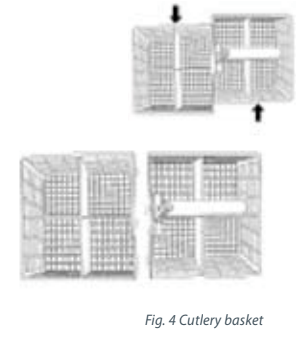
How to load the upper rack
The upper rack is designed to hold items like glasses, cups, saucers, plates, small bowls and shallow pans. Position these items so that they cannot be moved during the wash.
Upper rack adjustment for models DW60CSW1 and DW60CSX1
- The upper rack can be adjusted for height by using the rollers located on both sides of the rack (see below).
- Adjusting the upper rack to a higher level will give you more space to accommodate taller items in the lower rack.
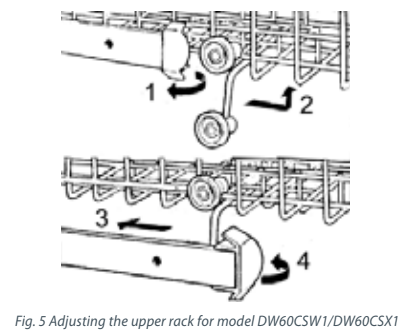
Upper rack adjustment for models DW60CDW2 and DW60CDX2
The upper rack can be adjusted for height using the levers located on both sides of the rack (see below).
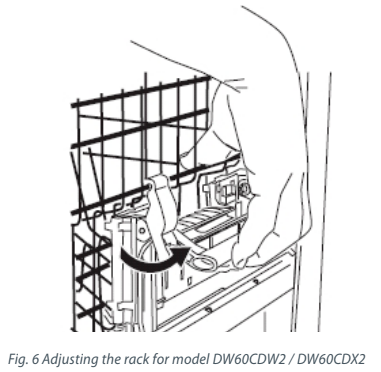
Detergent
Important!
- Never sprinkle or pour detergent directly onto any item in the dishwasher.
- Hand washing liquids, soap, laundry detergents or disinfectants will damage your dishwasher.
Filling the detergent dispenser
- Press the button on the top of the dispenser to open the cover.
- Pour the detergent for the wash cycle into the larger main detergent compartment.
- Pour the detergent for the pre-wash cycle into the smaller prewash detergent compartment.
- Remove any excess detergent from the edges of the dispenser.
- Close the cover and press down until it clicks into place. The detergent will automatically be released into the dishwasher during the wash programme.
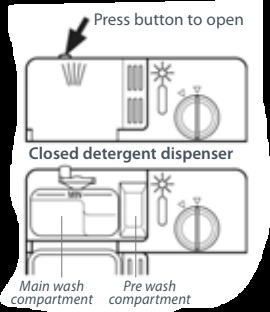
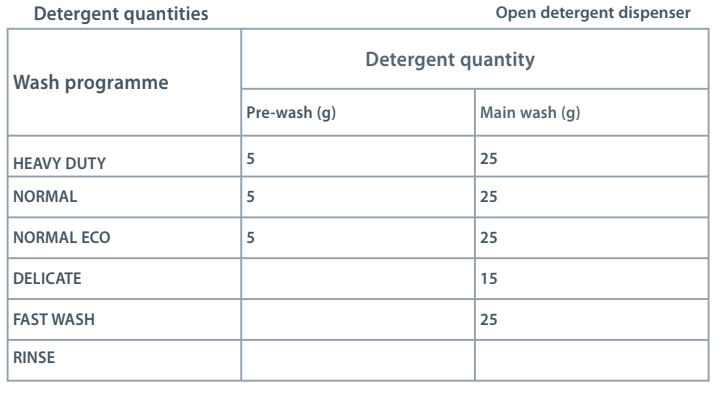
Important!
- Dishwasher detergents are strongly alkaline and can be dangerous if swallowed.
- Avoid contact with skin and eyes.
- Keep children and infirm persons away from the dishwasher when the door is open.
- Check that the detergent receptacle is empty after the completion of the wash cycle – failure to do so could result in poisoning.
We highly recommend the regular use of liquid rinse aid to give the best drying results. Rinse aid gives a streak-free, sparkling clean look to glass and chinaware. In addition it prevents metal from tarnishing. The rinse aid dispenser is located on the inside panel of the door.
Filling the rinse aid dispenser
1. Open the dispenser by turning the cap in an anticlockwise direction.
2. Pour the rinse aid into the dispenser, making sure not to overfill.
Take care not to spill rinse aid into the dishwasher. Any spills must be wiped up to prevent excess foaming. Failure to wipe up rinse aid spills may result in a service call, which will not be covered by warranty.
3. Fit the cap back in the original position.
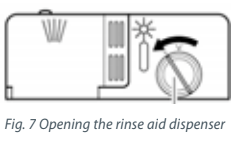
How much rinse aid to use
The dose regulator may need to be adjusted to suit your water conditions. Regulate the amount of rinse aid by turning the dose regulator, using a screwdriver. The dose regulator is located underneath the rinse aid cap.
There are six dosage settings; the lowest setting is ‘1’ and the highest setting is ‘6’. The normal dosage is setting ‘1’. If there is excessive foaming at the end of the wash, reduce the setting. If dishes are wet or streaky after drying, increase the setting.
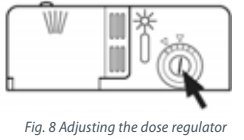
Rinse Aid indicator light
When the rinse aid level becomes low, the Rinse Aid indicator will light up to remind you to refill the rinse aid. The Rinse Aid indicator light can be found on the detergent dispenser cover for all models, and on the exterior control panel for models DW60CDW2 and DW60CDX2.
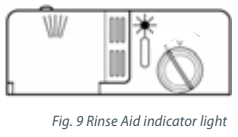
Care and cleaning
After each wash, turn off the water supply to the dishwasher and leave the door ajar 30°, so that moisture and odours are not trapped inside.
Important!
The door should not be left in the fully open position as this could present a tripping hazard.
Before cleaning or performing maintenance, always remove the power plug from the wall socket.
Cleaning the outer surfaces
From time to time the wash programme indicator panel and its surrounds need to be cleaned to remove food particles, and any spillages. We recommend wiping these areas with a clean, soft damp cloth, and drying them with a clean lint-free cloth.
Important! We do not recommend the use of the following cleaning aids on your dishwasher, as they may damage the surfaces:
- Plastic or stainless steel scouring pads.
- Abrasive, solvent house hold cleaners.
- Hand washing liquids or soaps.
- Laundry detergents or disinfectants.
Cleaning the door seals
If food is trapped in the seals, then it can cause odours. Clean the seals periodically with a clean damp cloth to prevent this from happening.
Holiday time
If your dishwasher is not going to be used for some time, we recommend you ensure the baskets are empty. Leave the inside of the dishwasher clean. Leave the door ajar to allow air to circulate. Turn off both the power and water supply to your dishwasher.
Cleaning the drain filters and spray arms
Regular inspection and maintenance of your dishwasher helps to prevent problems from occurring. You should carefully inspect your dishwasher regularly. Check that no grease or scale has accumulated on the inside of your dishwasher. If you discover any deposits, clean them thoroughly with warm water on a soft, lint-free cloth.
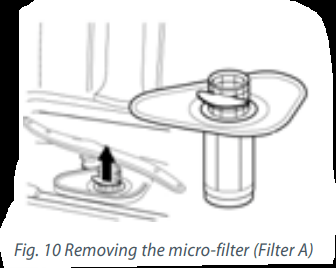
Filters
The filters A and B prevent larger particles of food in the water from reaching the pump. These particles may occasionally block the filters. We recommend that the drain filter is cleaned whenever there is evidence of food particles.
- When the dishwasher has finished washing, check the filters for particles of food and, if required, clean.
- After removing the coarse micro-filter (filter A), the filter unit (filter B) can be removed. Remove any particles of food and rinse the filters under running water.
- Replace the filter unit (B) and then the coarse micro-filter (A). Ensure that the micro-filter is tightened firmly.
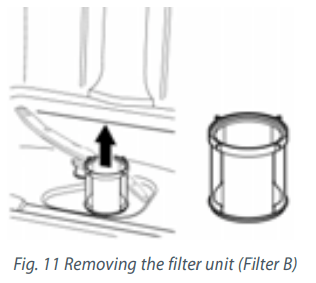
Spray arms
Lime and remnants of food in the wash water can block the nozzles in the spray arms and the arm mountings The spray arms and mountings may need cleaning about once a month in normal use or more often should the need arise:
- Inspect the nozzles in the spray arms for blocked holes.
- If necessary, unscrew the lower arm (C) and lift it off. Unscrew the upper spray arm (D).
- Clean both spray arms under running water.
- Refit the spray arms. Ensure that the lower spray arm is locked into place and the upper one is screwed tightly.

Important ! The dishwasher must be used with the filter plate, drain filter and spray arms correctly in place. Where there is broken crockery or glass in the dishwasher, carefully and immediately remove it to prevent damage.
Fault codes
Please read the following pages before you call for service.
You can correct many of your dishwasher’s problems yourself, using the checklists on the following pages.
| Problem | Fault code | Possible causes | What to do |
|---|---|---|---|
| First 2 programme indicators flashing | E1 | The door is not properly closed. | Close the door firmly. |
| 1 and 3 programme indicator lights flashing | E2 | Temperature sensor faulty | Turn the water and power off to the dishwasher. Call your Fisher & Paykel dealer or Authorised Service Centre. |
| 1 and 4 programme indicator lights flashing | E3 |
Drain hose is too low. The wash water level is too low. |
Ensure that drain hose is connected in accordance with the ‘Installation instructions’. |
| Programme indicators 1, 3 and 4 flashing | E4 |
Drain hose is crimped or bent. The wash water is not draining out. Drain hose is too high. |
Check hose and straighten if needed. Ensure that drain hose is connected in accordance with the ‘Installation instructions’. |
| First 3 programme indicators flashing | E5 |
Water tap not turned on. Insufficient water supply pressure. Water supply hose is crimped or bent. Drain hose is too low. |
Ensure the water is connected and turned on. Check household water pressure. Check hose and straighten if needed. Ensure that drain hose is connected in accordance with the ‘Installation instructions’ |
| First 4 programme indicators flashing | E6 | Flood switch activated. | Turn the water off and the mains power off to the dishwasher. Call your Fisher & Paykel dealer or authorised service centre. |
If the dishwasher still will not work, or shows any other error display:
- Power the dishwasher OFF and wait for a few minutes.
- Power the dishwasher ON and retry.
If the dishwasher still does not function, and/or the problem persists, contact your Fisher & Paykel Dealer or Authorised Service Centre.
Troubleshooting
| Problem | Probable cause | What to do |
|---|---|---|
| Dishwasher will not start. | Dishwasher will not start. | Connect the power supply. |
| The door is not properly closed. | Close the door. | |
| Programme button has not been pressed. | Select a programme. | |
| Water tap not turned on. | Ensure the water is connected and turned on. | |
| Blocked strainer in water intake hose. | Check strainer – located in the inlet supply hose where it screws into the tap. | |
| Lower spray arm rotates with difficulty. | difficulty. Spray arm is blocked by small items or food remains. | Clean spray arm. |
| Lid of detergent dispenser cannot be closed. | Detergent compartment has been overfilled. | Remove detergent until the lid can be closed. |
| Detergent dispenser is clogged with remnants of detergent. | Wipe dispenser out with a damp cloth. Dry before adding detergent. | |
| Remnants of detergent stuck inside dispenser. | Compartment was damp when filled with detergent. | Turn the Power button off. |
| Water remains inside dishwasher after wash has ended. | Drain hose is crimped, bent or blocked. | Check hose and straighten if needed. |
| Pump is jammed. | Call your Fisher & Paykel Authorised Service Centre. | |
| Filter/s blocked. | Clean the filter/s. | |
| The wash is still running. | Wait for the programme to end. | |
| Foaming. | Incorrect amount/type of detergent used. | See the ‘Detergent’ section or consult the detergent manufacturer’s instructions. |
| Too much egg in the wash load. | Increase the amount of detergent. | |
| Rinse aid setting too high. | Decrease the rinse aid setting. | |
| Rinse aid spills not wiped up. | Ensure that all rinse aid spills are wiped up when they occur. | |
| Stops suddenly during wash. | Power supply has been interrupted. | Check power supply |
| Water supply has been interrupted. | Check water supply. | |
| Knocking or rattling sound during wash. | Spray arm knocking against dishes. | Stop cycle and reposition dishes. |
| Dishes have been stacked incorrectly. | Stop cycle and reposition dishes. | |
| Unclean dishes. | Wash programme unsuitable for load or soils were too heavily baked on and dishes may need soaking. | See the ‘Wash programme chart’ for a suitable wash programme. |
| Spray arm unable to rotate. | Ensure no items are obstructing the spray arm path. | |
| Dishwasher overloaded/ incorrectly loaded. | See the ‘Loading’ section. | |
| The filters are incorrectly inserted. | See the ‘Care and cleaning’ instructions. | |
| Detergent put in the wrong compartment. | Put detergent in the large (main wash) compartment. | |
| Excessive food not removed from dinnerware prior to cleaning. | Scrape all food scraps off dinnerware prior to loading. | |
| Unsuitable detergent. | Use recommended brands of dishwasher detergent. | |
| Not enough detergent. | See the ‘Detergent’ section or the detergent manufacturer’s instructions. | |
| Spray arm holes are blocked. | Clean the spray arm. | |
| The filters are blocked. | Clean the filters. | |
| Plastic items are discoloured. | Not enough detergent. | Pre-rinse dishes before placing in the dishwasher. Alternatively, using the rinse programme after adding dishes may minimise staining. |
| White stains are left on dishes; glasses have a milky appearance. | Not enough detergent. | See the ‘Detergent’ section or the detergent manufacturer’s instructions. |
| Rinse aid set too low. | Increase rinse aid dose setting. | |
| Dishes, cutlery have not dried. | Selected programme did not include drying function. | Select wash programme with drying function. |
| Rinse aid set too low. | Increase rinse aid setting. See the ‘Rinse aid’ section. | |
| Items removed too soon. | Wait until dishwasher beeps to indicate the end of the programme. | |
| Glasses have dull appearance. | Rinse aid set too low. | Increase rinse aid setting. See the ‘Rinse aid’ section. |
| Tea stains or traces of lipstick have not been completely removed. | Not enough detergent. | See the ‘Detergent’ section or the detergent manufacturer’s instructions. |
| Wash temperature too low. | Select wash programme with higher temperature. | |
| Traces of rust on cutlery. | Cutlery is not sufficiently rust proof. | Wash by hand. |
| Glasses clouded and discoloured; coating cannot be removed. | Unsuitable detergent. | Use recommended brands of dishwasher detergent. |
| Glasses are not dishwasher proof | Wash by hand. | |
| Smears left on glasses and cutlery. | Rinse aid set too high. | Reduce rinse aid setting. See the ‘Rinse aid’ section. |
See other models: E450RW1 RF522BLGW6 RF610ADUB5 CI302CTB1 RF522ADUSX5
